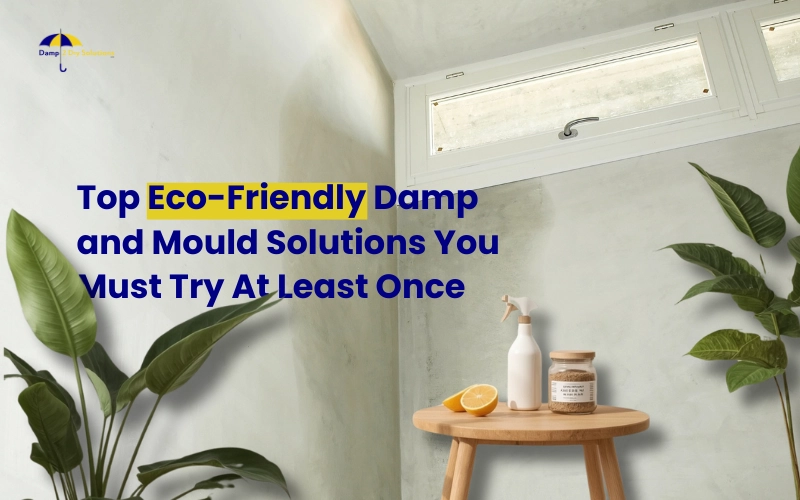
Damp and mould are a problem in homes right across the UK.
In fact, government figures suggest that anywhere between a million and over six million households could be living with it. If you’ve ever had to stop mould on walls or wipe away damp patches on the ceiling, you’ll know how quickly it creeps back.
The first instinct for many is to grab bleach or a strong spray, but these harsh products aren’t a lasting anti mould treatment. They often leave behind fumes, damage surfaces, and do little more than hide the mould for a while.
The good news is that there are plenty of eco-friendly ways to tackle the issue. From simple cupboard remedies to breathable building materials, these approaches make your home healthier and cleaner.
This guide will show you natural solutions and answer common questions like how can you get rid of black mould, the most stubborn type, as well as green, white, and pink mould that often appear in UK homes.
Understanding Damp and Mould Before You Treat It
Damp is simply the unwanted moisture, and it shows in three common ways.
The first and the most common one is condensation. You’ll see beads of water on windows after a hot shower or steam on the kitchen tiles. That’s condensation.
Then there’s rising damp, where water creeps up from the ground and leaves tide marks on walls. And finally, penetrating damp, the kind that sneaks in through leaky roofs, cracked render, or dodgy guttering.
Once damp sets in, mould follows. It’s a fungus that loves these damp spots, spreading quickly and leaving dark patches, peeling paint, or that unmistakable musty damp smell. Sometimes the wall itself feels clammy or cold to the touch.
Beyond the look and smell, mould can make breathing harder, triggering asthma or allergies. That’s why knowing how to remove a mould properly matters. Start small with natural mould removal remedies for light patches, but think longer term if you want to know how to get rid of mould on walls permanently.
If the problem’s black mould (Stachybotrys), the stubborn type, calling in a professional is always the safest option. More on that later!
Eco-Friendly Ways to Tackle Small Mould Problems
One often assumes that bleach and harsh sprays can fight off mould fast, but they couldn’t be more wrong. Such chemical-filled solutions rarely fix the problem. They give off strong fumes and leave residue that can irritate the skin & lungs. Even then, it doesn’t guarantee that mould won’t reappear soon.
Eco-friendly methods work differently. They use safe ingredients you often already have at home, they improve indoor air quality, and they don’t add chemicals to the environment. Better still, they can be just as effective as commercial products.
Here are seven proven, natural ways of removing mould from your home that are safe, sustainable, and easy to follow.
Option 1: White Vinegar
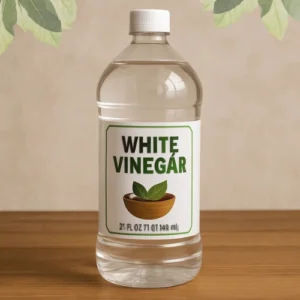
Vinegar has been used for years. It’s naturally acidic and affordable too. Once you spray, its acidity can change the surface’s pH, so it’s quite hard for mould spores to grow back easily. It’s a disinfectant too, so you aren’t just wiping away mould from the surface; you kill it inside your walls too.
To use vinegar for mould, grab a spray bottle, pour in plain white vinegar (don’t dilute it), and spray the patch until it’s damp. Leave it for about an hour. The longer you leave it, the better chance it has of soaking in. After that, scrub with a brush or even an old cloth, then wipe with clean water.
It’s best on things like tiles, glass, and painted walls. Don’t use it on marble or natural stone, as the acid will mark the surface. The smell is sharp at first, but it clears once the area dries, which is why many people keep vinegar as their first choice.
Option 2: Baking Soda
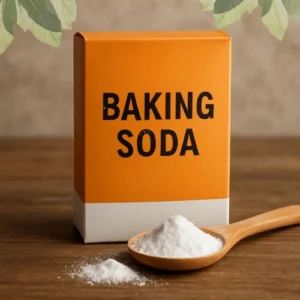
Baking soda is an alkali, which of course, available in almost every kitchen. It works by sucking out moisture, and mould can’t survive without moisture. Also, baking soda is a bit gritty, so you can scrub off the spores, and the surface won’t get damaged.
Here’s how to use it:
- First, mix baking soda with a little water to make a paste.
- Then, spread it over the mould patch.
- Further, leave it for ½ an hour.
- After that, scrub it off with a sponge or brush. Don’t forget to rinse it with clean water.
- Pat the area dry and your surface will be mould-free.
You’ll find baking soda relatively safer to use as compared to vinegar, especially when you want something gentle but effective. Apply it on painted walls, wood, and even tiles, and it won’t leave behind any strong smell.
Option 3: Tea Tree Oil
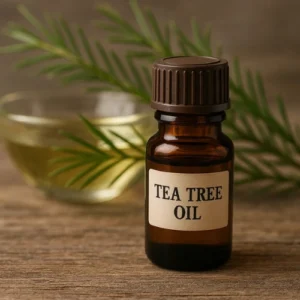
Well, tea tree oil isn’t a kitchen staple like vinegar or baking soda. But it’s also one of the strongest ways of removing mould naturally. It has amazing antifungal and antibacterial properties that kill the mould for good. That means you can use it both as a cleaner and as a preventive treatment. The smell can be a bit different, but not as pungent as vinegar.
To use tea tree for mould cleanup, mix about 15 drops of it with two cups of water and pour the liquid in a spray bottle. Then, shake it well and spray directly on the mould patch. Let it stay for at least an hour. Finally, scrub the area with a brush and wipe away residue with a damp cloth.
Tea tree oil is great for mould in bathrooms and kitchens because these are never seen to dry out properly. Spray it on and don’t rinse afterwards; the thin layer left behind actually helps to keep the spores from returning. The smell is strong at first, but it fades, and the best part is you only need a few drops. A small bottle will easily last months.
Option 4: Hydrogen Peroxide (3%)
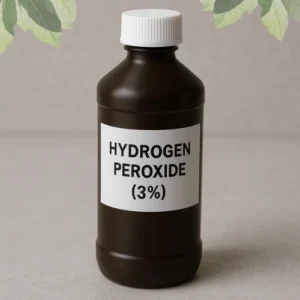
You won’t find hydrogen peroxide in your kitchen cupboard, but you can definitely get it cheap from a chemist.
At 3% concentration, it’s a safe and eco-friendly option compared to bleach. Why is it called “green”? Because it breaks down in just water and oxygen, and it leaves no harmful residue. That makes it completely safe to use as a mould spray indoors.
Its application is very easy. Just pour the solution into a spray bottle and spray it on the mould patch well. Leave it for 10-15 minutes for best results, and then scrub it away with a brush and wipe down with a damp cloth.
But we suggest you first do a small patch test. That way, you can figure out if hydrogen peroxide lightens up the paint on your wall.
It’s especially effective in bathrooms, where you often need to remove mould from walls, grout, or tiles. Store it in a dark cupboard, as light weakens the liquid over time. For stubborn patches where vinegar hasn’t worked, this is a reliable next step without the risks of bleach.
Option 5: Vodka

It might sound odd, but plain vodka can be surprisingly effective as a mould treatment. The alcohol content is high enough to kill mould spores, making it a decent disinfectant when you don’t want to bring in bleach or other harsh products.
Here’s how to use it:
- Pour cheap, unflavoured vodka into a spray bottle.
- Mix it half-and-half with water.
- Spray it directly onto the mould patch.
- Leave it for 10–15 minutes to do its job, then scrub with a cloth or brush and wipe clean with water.
You don’t need anything fancy; the cheapest supermarket brand will work just as well. Vodka is handy if you’re wondering, “How can I get rid of mould quickly?” It works best on tiles, glass, and other hard surfaces. It’s not strong enough to be your only black mould remover, but it’s a good option for small outbreaks or as a follow-up once the main patch is cleared.
Option 6: Citrus Seed Extract
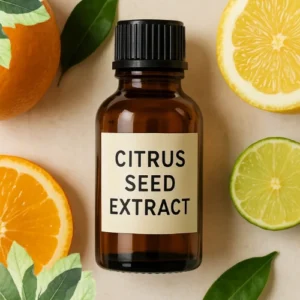
Citrus seed extract, usually made from grapefruit or lemon seeds, is a gentle but effective option if you want a natural spray for mould removal without the harsh smells of vinegar or strong chemicals. It contains natural acids that break down spores while leaving behind a residue that helps to stop them coming back.
To use it, mix about 20 drops of citrus seed extract with half a litre of water in a spray bottle. Cover the mould patch thoroughly and let it dry naturally; no need to rinse! The leftover film on the surface continues working in the background.
This method is useful if you’re aiming for how to get rid of black mould on walls permanently, since regular use keeps the surface unfriendly to mould growth. It’s safe on most household surfaces and a good choice if you want a routine cleaner.
For stubborn spots, it works well alongside stronger remedies and gives you a natural edge in learning how to eliminate black mould without harsh products.
Option 7: Oxygen Bleach (Green Bleach)
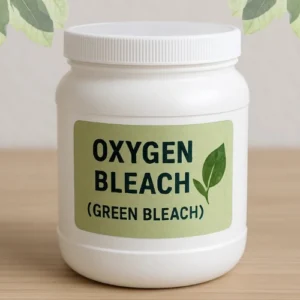
Oxygen bleach, or, say, green bleach, is a safer alternative to chlorine bleach. When you apply it, it breaks down mould spores, lifts them from the surface and only releases oxygen. It neither damages the material nor does it leave any toxic fumes. It’s your best bet when you Google “how to remove mould permanently without toxic chemicals”.
To use it, follow the instructions on the packet, which is usually mixing the powder with warm water, applying the solution to the mould patch and then leaving it for 10–15 minutes. Once you’ve done all of that, scrub with a brush and rinse the surface clean.
It’s particularly handy for removing mould on washable surfaces and fabrics where other remedies have failed. Many homeowners ask, “How do you get rid of mould in bathroom tiles or grout?” The right answer in this case is oxygen bleach, because it is one of the stronger eco options that can give lasting results without the drawbacks of chlorine bleach.
Everyday Eco Damp Control & Prevention Habits
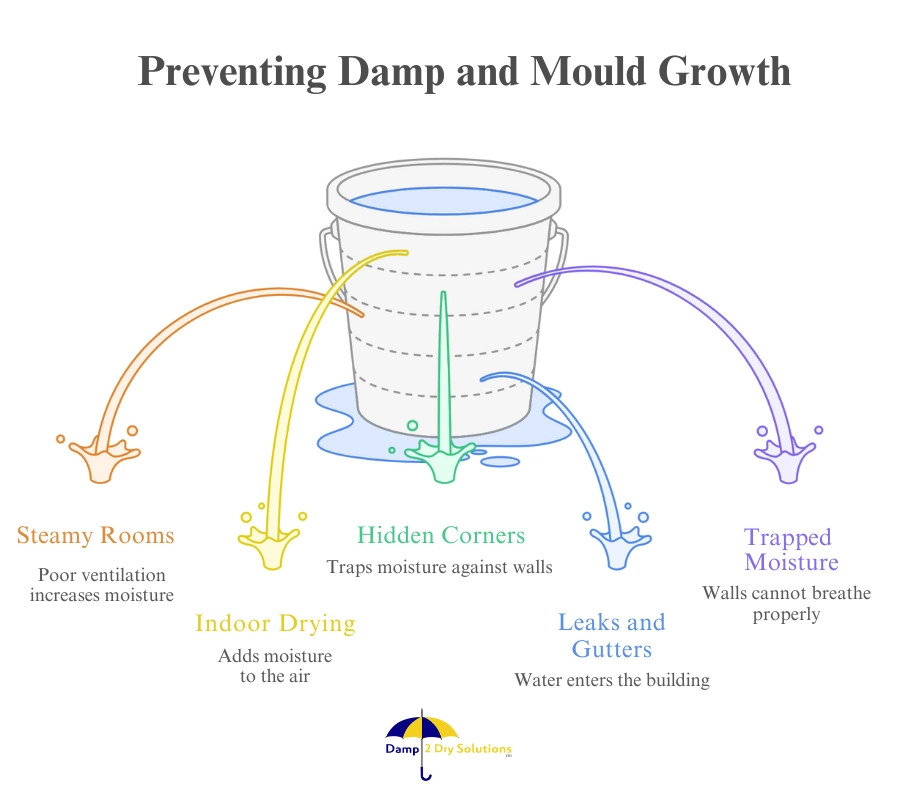
Once you’ve cleaned a mould patch, the real challenge is keeping it from coming back. Most problems boil down to moisture. So, let’s look at the common causes and the eco-friendly fixes that work.
Problem: Steamy kitchens and bathrooms.
Solution: Use extractor fans, pan lids, and open windows whenever possible. Good airflow is one of the simplest ways to eliminate mould in house before it spreads.
Problem: Clothes drying indoors.
Solution: Dry laundry outdoors when you can. If you have to dry it inside, choose one room, keep the door shut, and crack open a window so the moisture escapes.
Problem: Hidden corners and cold walls.
Solution: Pull wardrobes and sofas a little away from external walls and pop natural dehumidifiers like salt pots or charcoal bags in tight spaces. This extra airflow means you’ll spend less time removing black mould from wall surfaces.
Problem: Leaks and blocked gutters.
Solution: Regularly clean gutters, repair roof tiles, and check pipework. Neglecting these is one of the quickest ways to end up with green mould on walls.
Problem: Moisture trapped in walls and finishes.
Solution: If you’re redecorating, use lime plaster, mineral paints, or natural insulation (like hemp or wool). These breathable materials let moisture escape instead of trapping it. Swap plastic sealants for linseed putty to give your walls a natural safety net.
By changing a few habits and doing eco-friendly upgrades, you can have a home that has least chances of having a damp and mould situation, and is a comfortable home to live in.
Advanced Eco-Friendly Damp Solutions
Everyday remedies are a good start, but sometimes damp needs more than cupboard fixes. If you’ve tried basics like how to clean mould with vinegar and it still keeps coming back, the root cause is usually poor airflow or trapped moisture.
Eco-friendly building options can help. Positive Input Ventilation (PIV) systems bring in filtered fresh air and push out humid air. Breathable plasters and natural insulation materials, like lime or hemp, let walls release moisture instead of sealing it in. In stubborn cases, mineral-based paints and eco tanking plasters are used to stop damp from spreading through basements or underground walls.
For anyone asking “how do you remove black mould for good?” these upgrades, combined with good daily habits, are what make the difference between temporary fixes and long-term results.
When Is the Right Time to Call the Professionals?
Eco-friendly fixes are a great first step. A vinegar mould treatment or baking soda paste can clear smaller patches, but when mould keeps returning, it’s a sign the underlying damp hasn’t been solved. Large outbreaks, like cleaning black mould from walls, can also be risky since disturbing spores can affect your health.
This is when professional help matters. A damp survey doesn’t just treat what you see; it diagnoses the root cause. Surveyors can confirm if the issue is condensation, penetrating damp, or rising damp and then recommend eco-conscious solutions that last.
If you’ve been asking “how do I get rid of mould on walls for good?” the truth is that household cleaning alone won’t guarantee it. Prevention habits and natural remedies play their part, but a professional damp survey is the only way to be certain the problem won’t keep coming back.
Book a damp survey with Damp 2 Dry Solutions to protect your home and breathe healthier, cleaner air with confidence.
